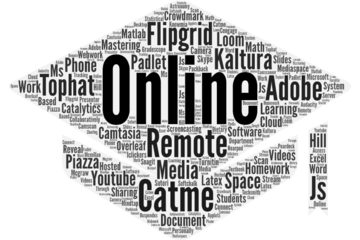Browse
Assessing Learning
Posted on: #iteachmsu

ASSESSING LEARNING
Advantages of Software as service cloud computing layer
1) SaaS is easy to buy
SaaS pricing is based on a monthly fee or annual fee subscription, so it allows organizations to access business functionality at a low cost, which is less than licensed applications.
Unlike traditional software, which is sold as a licensed based with an up-front cost (and often an optional ongoing support fee), SaaS providers are generally pricing the applications using a subscription fee, most commonly a monthly or annual fee.
2. One to Many
SaaS services are offered as a one-to-many model means a single instance of the application is shared by multiple users.
3. Less hardware required for SaaS
The software is hosted remotely, so organizations do not need to invest in additional hardware.
4. Low maintenance required for SaaS
Software as a service removes the need for installation, set-up, and daily maintenance for the organizations. The initial set-up cost for SaaS is typically less than the enterprise software. SaaS vendors are pricing their applications based on some usage parameters, such as the number of users using the application. So SaaS does easy to monitor and automatic updates.
5. No special software or hardware versions required
All users will have the same version of the software and typically access it through the web browser. SaaS reduces IT support costs by outsourcing hardware and software maintenance and support to the IaaS provider.
6. Multidevice support
SaaS services can be accessed from any device such as desktops, laptops, tablets, phones, and thin clients.
7. API Integration
SaaS services easily integrate with other software or services through standard
SaaS pricing is based on a monthly fee or annual fee subscription, so it allows organizations to access business functionality at a low cost, which is less than licensed applications.
Unlike traditional software, which is sold as a licensed based with an up-front cost (and often an optional ongoing support fee), SaaS providers are generally pricing the applications using a subscription fee, most commonly a monthly or annual fee.
2. One to Many
SaaS services are offered as a one-to-many model means a single instance of the application is shared by multiple users.
3. Less hardware required for SaaS
The software is hosted remotely, so organizations do not need to invest in additional hardware.
4. Low maintenance required for SaaS
Software as a service removes the need for installation, set-up, and daily maintenance for the organizations. The initial set-up cost for SaaS is typically less than the enterprise software. SaaS vendors are pricing their applications based on some usage parameters, such as the number of users using the application. So SaaS does easy to monitor and automatic updates.
5. No special software or hardware versions required
All users will have the same version of the software and typically access it through the web browser. SaaS reduces IT support costs by outsourcing hardware and software maintenance and support to the IaaS provider.
6. Multidevice support
SaaS services can be accessed from any device such as desktops, laptops, tablets, phones, and thin clients.
7. API Integration
SaaS services easily integrate with other software or services through standard
Posted by:
Rohit 936 shinde

Posted on: #iteachmsu


Advantages of Software as service cloud computing layer
1) SaaS is easy to buy
SaaS pricing is based on a monthly fee or an...
SaaS pricing is based on a monthly fee or an...
Posted by:
ASSESSING LEARNING
Thursday, Feb 4, 2021
Posted on: #iteachmsu

ASSESSING LEARNING
Software Virtualization in the cloud computing
Managing applications and distribution becomes a typical task for IT departments. The installation mechanism differs from application to application. Some programs require certain helper applications or frameworks and these applications may have a conflict with existing applications.
Software virtualization is just like virtualization but able to abstract the software installation procedure and create virtual software installations.
Virtualized software is an application that will be "installed" into its own self-contained unit.
Advantages of Software Virtualization
1) Client Deployments Become Easier:
Copying a file to a workstation or linking a file in a network then we can easily install virtual software.
2) Easy to manage:
Manage updates becomes a simpler task. You need to update at one place and deploy the updated virtual application to all clients.
Software virtualization is just like virtualization but able to abstract the software installation procedure and create virtual software installations.
Virtualized software is an application that will be "installed" into its own self-contained unit.
Advantages of Software Virtualization
1) Client Deployments Become Easier:
Copying a file to a workstation or linking a file in a network then we can easily install virtual software.
2) Easy to manage:
Manage updates becomes a simpler task. You need to update at one place and deploy the updated virtual application to all clients.
Posted by:
Rohit 936 shinde

Posted on: #iteachmsu


Software Virtualization in the cloud computing
Managing applications and distribution becomes a typical task for I...
Posted by:
ASSESSING LEARNING
Wednesday, Feb 3, 2021
Posted on: #iteachmsu

ASSESSING LEARNING
Search engine optimization
Introduction:
Search engine optimization (SEO)is the process of optimizing your online content so that a search engine likes to show it as a top result for searches of a certain keyword.
we can follow these seven steps to successful SEO:
Crawl accessibility so engines can read your website
Compelling content that answers the searcher’s query
Keyword optimized to attract searchers & engines
Great user experience including a fast load speed and compelling UX
Share-worthy content that earns links, citations, and amplification
Title, URL, & description to draw high CTR in the rankings
Snippet/schema markup to stand out in SERPs
Search engine optimization (SEO)is the process of optimizing your online content so that a search engine likes to show it as a top result for searches of a certain keyword.
we can follow these seven steps to successful SEO:
Crawl accessibility so engines can read your website
Compelling content that answers the searcher’s query
Keyword optimized to attract searchers & engines
Great user experience including a fast load speed and compelling UX
Share-worthy content that earns links, citations, and amplification
Title, URL, & description to draw high CTR in the rankings
Snippet/schema markup to stand out in SERPs
Authored by:
Rohit

Posted on: #iteachmsu


Search engine optimization
Introduction:
Search engine optimization (SEO)is the process o...
Search engine optimization (SEO)is the process o...
Authored by:
ASSESSING LEARNING
Thursday, Jan 28, 2021
Posted on: #iteachmsu

ASSESSING LEARNING

Posted on: #iteachmsu


Test Article
Testing
Authored by:
ASSESSING LEARNING
Friday, Jan 1, 2021
Posted on: #iteachmsu

ASSESSING LEARNING
Response Accommodations
Educators should understand that students with disabilities often encounter barriers when they access the general education curriculum. The Every Student Succeeds Act (ESSA) and the Individuals with Disabilities Education Improvement Act (IDEA) require that educators provide appropriate accommodations to students with disabilities to address these barriers. Careful consideration of a student’s strengths and needs can help guide the identification and selection of an accommodation that is likely to benefit a student.
RE: https://microcredentials.digitalpromise.org/explore/response-accommodations
Response Accommodations
Response Accommodations
Educators should understand that students with disabilities often encounter barriers when they access the general education curriculum. The Every Student Succeeds Act (ESSA) and the Individuals with Disabilities Education Improvement Act (IDEA) require that educators provide appropriate accommodations to students with disabilities to address these barriers. Careful consideration of a student’s strengths and needs can help guide the identification and selection of an accommodation that is likely to benefit a student.
RE: https://microcredentials.digitalpromise.org/explore/response-accommodations
Posted by:
Scarlet Ethan Edien

Posted on: #iteachmsu

Response Accommodations
Educators should under...

Response Accommodations
Response Accommodations
Educators should under...
Posted by:
ASSESSING LEARNING
Thursday, Dec 31, 2020
Posted on: #iteachmsu

ASSESSING LEARNING
Data Science, Deep Learning, and Artificial Intelligence
Artificial Intelligence
The term “AI” is used so often nowadays that we have a basic understanding of what it means: a computer’s ability to perform tasks such as visual perception, speech recognition, decision-making, and language translation. AI has progressed rapidly over the last few years, but it is still nowhere near matching the vast dimensions of human intelligence. Humans make quick use of all the data around them and can use what they have stored in their minds to make decisions. However, AI does not yet boast such abilities; instead, it is using huge chunks of data to clear its objectives. This ultimately means that AI might require huge chunks of data for doing something as simple as editing text.
Data Science
Data science is much more than just simple machine learning. Data here may not have been obtained through a machine, and it may not even be for learning purposes. Put, data science tends to cover the whole spectrum of data processing as we know it. Data science is not just related to the statistical aspect of the process, but it feeds the process and derives benefits from it through data engineering. Data engineers and data scientists have a huge role to play in propelling AI forward.
Deep Learning
Deep learning is machine learning’s most powerful technique for making the future happen. Much like the neurons in our brains, deep learning is the connection or the powerhouse present between data science and AI. Both machine learning and its subtype, deep learning, incorporate the process of learning from the data over time. While it is not the only thing connecting the two, deep learning is a type of machine learning that works best to strengthen the process of AI and data science. Deep learning can be defined as a machine learning technique that endeavors to teach computer systems things that come naturally to humans. For example, we can naturally interpret what a stop sign on the road means, but for a machine to locate this sign and interpret it, it needs a lot of learning and implementation.
The term “AI” is used so often nowadays that we have a basic understanding of what it means: a computer’s ability to perform tasks such as visual perception, speech recognition, decision-making, and language translation. AI has progressed rapidly over the last few years, but it is still nowhere near matching the vast dimensions of human intelligence. Humans make quick use of all the data around them and can use what they have stored in their minds to make decisions. However, AI does not yet boast such abilities; instead, it is using huge chunks of data to clear its objectives. This ultimately means that AI might require huge chunks of data for doing something as simple as editing text.
Data Science
Data science is much more than just simple machine learning. Data here may not have been obtained through a machine, and it may not even be for learning purposes. Put, data science tends to cover the whole spectrum of data processing as we know it. Data science is not just related to the statistical aspect of the process, but it feeds the process and derives benefits from it through data engineering. Data engineers and data scientists have a huge role to play in propelling AI forward.
Deep Learning
Deep learning is machine learning’s most powerful technique for making the future happen. Much like the neurons in our brains, deep learning is the connection or the powerhouse present between data science and AI. Both machine learning and its subtype, deep learning, incorporate the process of learning from the data over time. While it is not the only thing connecting the two, deep learning is a type of machine learning that works best to strengthen the process of AI and data science. Deep learning can be defined as a machine learning technique that endeavors to teach computer systems things that come naturally to humans. For example, we can naturally interpret what a stop sign on the road means, but for a machine to locate this sign and interpret it, it needs a lot of learning and implementation.
Posted by:
Rohit 936 shinde

Posted on: #iteachmsu


Data Science, Deep Learning, and Artificial Intelligence
Artificial Intelligence
The term “AI” is used so often nowadays tha...
The term “AI” is used so often nowadays tha...
Posted by:
ASSESSING LEARNING
Thursday, Dec 31, 2020
Posted on: #iteachmsu

ASSESSING LEARNING

Posted on: #iteachmsu


Test Image resize
dasdasdsadsada
Authored by:
ASSESSING LEARNING
Thursday, Dec 17, 2020
Posted on: #iteachmsu

ASSESSING LEARNING
Writing Style
There are four main types of writing: expository, descriptive, persuasive, and narrative. Each of these writing styles is used for a specific purpose. A single text may include more than one writing style.
Authored by:
Divya Sawant

Posted on: #iteachmsu


Writing Style
There are four main types of writing: expository, descriptive,...
Authored by:
ASSESSING LEARNING
Friday, Dec 11, 2020




